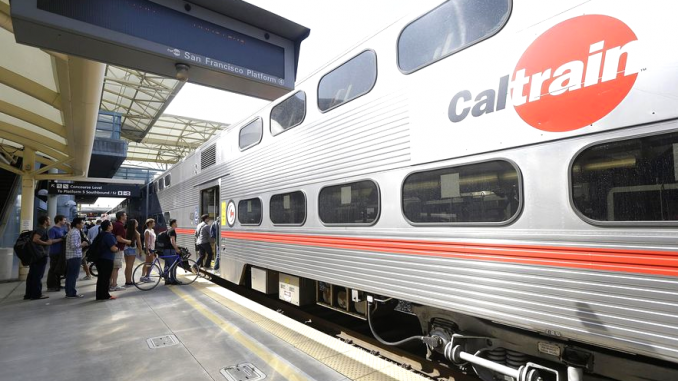
By the Daily Post staff
The idea of putting Caltrain in a tunnel from one end of Palo Alto to the other could come to a screeching halt on Monday night (Dec. 17).
For the past year, City Council has been whittling down a list of alternatives for the city’s train crossings — bridges, viaducts, outright closures, a trench and a tunnel — in an attempt to eliminate places where the train crosses at street level. The reason is that when trains roll through town more frequently, the crossing gates will be down longer, creating traffic backups.
One idea has been to bore a 4.2-mile tunnel from the north side of town, by San Francisquito Creek, to the Mountain View border.
The idea is popular but expensive — perhaps $1 billion a mile or more.
City Manager Jim Keene tomorrow night will recommend to council that it drop the idea of studying a citywide tunnel and instead direct consultants to study a short tunnel that would go underneath Meadow Drive and Charleston Road in the south part of town.
Other alternatives for the crossings are on the table too. Council, its Rail Committee and a Community Advisory Panel have been meeting all year to narrow the list of alternatives from 10 to a final plan. Originally, council wanted to have its choices for each crossing decided by the end of this year, but that deadline has been extended to February of next year.
In addition to ditching the citywide tunnel, Keene is recommending that council separate any study for the crossing at Palo Alto Avenue, on the far north side of town, from the rail planning effort and be included in a downtown coordinated area planning effort.
He also is asking council to separate the study of a bicycle and pedestrian crossing at Loma Verde Avenue from the rail program, and look at that idea in the future.
The council’s Rail Committee proposed the shorter south Palo Alto tunnel. The committee also encouraged the full council to look at keeping the current tracks at ground level for freight service and putting the passenger train underground beneath the Meadow and Charleston crossings.
But Keene, in a report to council in advance to tonight’s meeting, said the city’s rail consultant, AECOM, said that keeping the freight trains at ground level won’t save much money compared to a full tunnel combining passenger and freight trains. Plus, keeping the current tracks for freight trains eliminates the possibility of making money by selling the land above a tunnel.
Keene points out that a tunnel would obstruct Adobe and Barron creeks. If the city decides to go with a tunnel, the city would have to hire an engineer to come up with a system to divert the water under or over the tunnel.
The diversion, possibly by a pump station, would have to protect the fish and handle flood waters, Keene’s report indicates. Such a diversion would require the approval of numerous regulatory agencies.
Other ideas up for consideration include putting the train in a trench, elevating it on a viaduct or building bridges to put the train over the railway at Meadow and Charleston. Mountain View plans to put the train over Rengstorff Avenue in a project that is advancing to the environmental and engineering stage.
Financing any of the alternatives remains an open question. Santa Clara County voters in 2016 approved Measure B, a half-cent sales tax that would provide $700 million for Caltrain crossings in Palo Alto, Mountain View and Sunnyvale. Exactly how much money each city will receive is unknown at this point.
But Keene’s report said that for just the Meadow and Charleston alternatives, a trench would cost between $600 million and $800 million. Building bridges at each location would run between $200 million and $250 million. A viaduct would cost $400 million to $450 million.
During construction of a trench or bridges, the tracks would have to be temporarily moved to Alma Street, a detour called a “shoofly.” However, if the council picks a viaduct, a shoofly won’t be necessary. Digging a tunnel would require locations on both ends where the dirt could be piled up during construction.
Keene’s report says construction of a trench would take five years, bridges four years and a viaduct two years.
While council tomorrow night will reduce the alternatives for the crossings, the final plan won’t be decided upon until February at the earliest.




The lost opportunity here is linking Palo Alto’s planning with those of Menlo Park. The two cities should collaborate on planning and funding. Too bad neighbors can’t work together.
Why not ask Elon Musk to do the tunnel.?
I think Lydia Kou suggested that at a council meeting a few months ago, and Greg Scharff responded that he had already contacted Musk and he turned it down. I don’t know how hard Greg pushed the issue. Elon used to live in Palo Alto in his PayPal days, and felt strongly enough about our city that he located Tesla’s headquarters here.
Back in 2005/06 I was an engineer on a rail trench through downtown Reno. Lots of fun. It was a design-build contract meaning we both designed it and built it. For me the most interesting aspect of this project is the creek. In Reno we installed a huge siphon to solve a similar problem. For a creek, I don’t know. The ecology aspects are what seem the most important thing.
Does Keene think that somehow Palo Alto will be able to sell the CalTrain righ-of-way if the tracks are put in a tunnel? I’d like to see that in writing from the JPB.
@Forest, I’ve seen that trench in Reno! Good job!
The grade options for CalTrain along the entire route have been thoughtfully discussed on a blog over the past 10 years. There are many articles that discuss design options to achieve better service at lower cost.
http://caltrain-hsr.blogspot.com/2008/12/focus-on-palo-alto.html